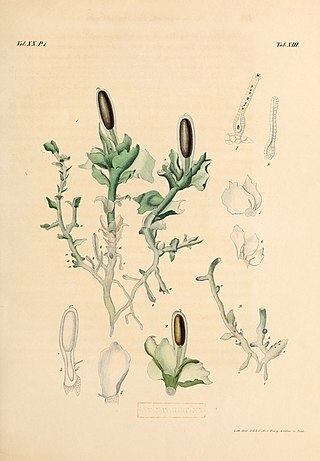
Jungermanniaceae is the namesake family of leafy liverworts. It is a group of small plants that are widely distributed. Several genera formerly included within the family are now classified in the Myliaceae or Solenostomataceae.

Lepidoziaceae is a family of leafy liverworts. It is a group of small plants that are widely distributed.

Aneuraceae is a family of thallose liverworts in the order Metzgeriales. Most species are very small with narrow, branching thalli.
Kymatocalyx rhizomaticus is a species of liverwort in the Cephaloziellaceae family. It is endemic to Malaysia. It was previously known as Stenorrhipis rhizomatica.

Herbertaceae is a family of liverworts. The family consists of the genera Herbertus, Schisma and Triandrophyllum. The genus HerpocladiumMitten, 1873 was later merged into the genus Herbertus.
Cryptothallus is a previously recognized genus of liverworts in the family Aneuraceae. The plants are small, and are white to pale green as a result of lacking chlorophyll. This feature led to the creation of a separate genus. The morphology of species assigned to Cryptothallus is very similar to that of Aneura. As a result, Karen Renzaglia in 1982 suggested that the only species then placed in the genus, Cryptothallus mirabilis, may be considered "merely as an achlorophyllous species of Aneura." Wickett and Goffinet argued the same position on the basis of sequences of nuclear, mitochondrial, and plastid DNA, and moved Cryptothallus mirabilis to Aneura. A 2010 molecular phylogenetic study confirmed the position of Cryptothallus within Aneura. This was accepted in the 2016 world checklist of hornworts and liverworts.

Solenostomataceae is a family of liverworts in the order Jungermanniales.

Lophoziaceae is a family of liverworts belonging to the order Jungermanniales.

Acrobolbaceae is liverwort family in the order Jungermanniales.

Dihydrostilbenoids (bibenzyls) are natural phenols formed from the dihydrostilbene (bibenzyl) backbone.

Gymnomitriaceae is a liverwort family in the order Jungermanniales.

Cephaloziaceae is a family of liverworts.

Leiomitra is a genus of liverworts in the family Trichocoleaceae.

Haplomitrium is a genus of liverworts.

Calypogeiaceae is a family of liverworts. This type of plant is a calcifuge.

Anastrophyllaceae is a family of liverworts belonging to the order Jungermanniales.
Balantiopsidaceae is a family of liverworts belonging to the order Jungermanniales.
Chonecoleaceae is a monotypic family of liverworts in the order Jungermanniales. It only contains the one genus Chonecolea.
Cleveaceae is a family of liverworts belonging to the order Marchantiales.
Lepidolaenaceae is a family of liverworts belonging to the order Porellales.













